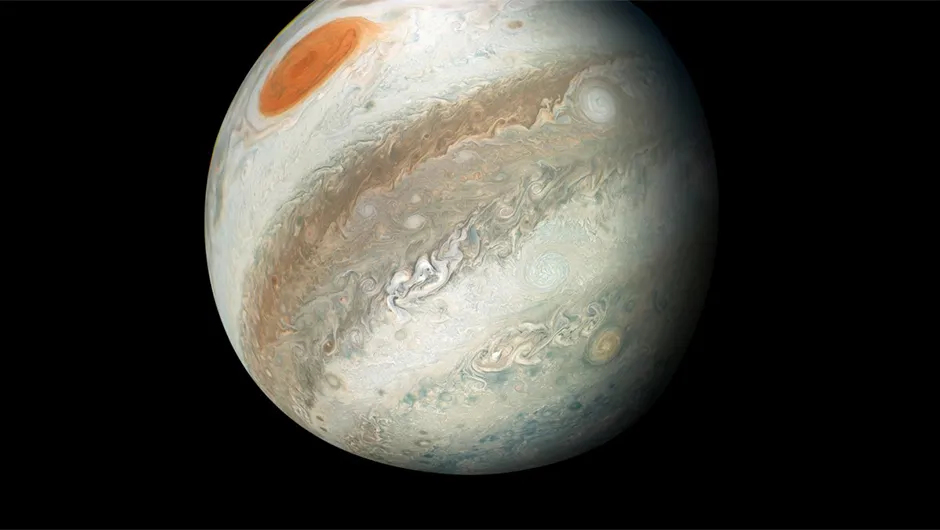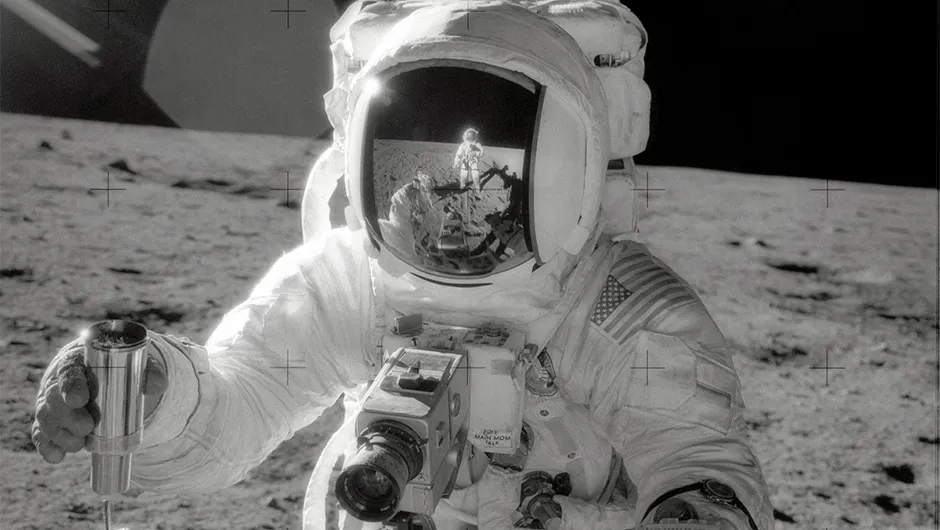The late heavy bombardment was a time of change and destruction, shaping the Solar System into the arrangement we know it today. Image Credit: iStock
When the Solar System first formed 4.5 billion years ago it was a violent place.
But quickly, by 4.4 billion years or so ago, the planets of the Solar System had calmed into a familiar configuration – several rocky inner planets surrounded by gas giants, ringed by icy objects.
Then, four billion years ago, something catastrophic happened.
The planets were thrown once more into chaos, and the face of the Solar System changed forever.
This period of upheaval reveals startling truths about the evolution of our home planetary system, and perhaps the origins of life itself.
In the Solar System’s first hundred million years or so, the beginnings of planets clumped together from the dust of a boiling protoplanetary disc around our young star.
Frequently the young planets would collide and grow larger, though sometimes they would be destroyed entirely.
To start, this early Solar System was much like it is today, but there were several key differences.
“Today, we have giant planets from Jupiter at about 5 AU from the Sun to Neptune at about 30 AU,” says William Bottke from the Southwest Research Institute in Boulder, Colorado.

1 AU is the distance between the Earth and the Sun.
“Modelling work shows the ice giants Neptune and Uranus would never have reached their current sizes if they had to form in the current configuration of the planets.
“Studies suggested instead that all these bodies formed between about 5 and 20 AU. Beyond that lies the Kuiper Belt.
“What’s interesting about the Kuiper Belt now is that a lot of objects have very special orbits, called resonances. It’s very hard to get them into these resonances.”
Synced surprise
A resonant orbit occurs when the ratio between the orbits of two bodies is two whole numbers.
Pluto and Neptune share a resonance: for every two orbits Pluto makes, Neptune completes three.
To explain what might have caused these resonances, as well as the change in the ice giants’ positions, a group of researchers in Nice, France, came up with what is now known as the Nice model in 2005.
“They suggested that you had a gigantic Kuiper Belt with maybe 10 Earth masses in it,” says Bottke.
“This lets you form Neptune and Uranus on reasonable timescales and you can make lots of Pluto-like objects in the primordial disc.”
Using this setup, the team created a computer model of the early Solar System.
It’s thought that a few hundred years after the formation of Jupiter, leftover gas dragged on the planet and caused it to drift deeper into the Solar System.
In time this caused the giant planets to fall into a resonance and their combined gravity acted on the surrounding Kuiper Belt objects, pulling them inwards.
In turn, these bodies pulled on the orbits of the gas giants.
Though only a small effect compared to that of the planets, little by little the icy rocks began to upset the precarious gravitational balance.
“They found that when the system becomes unstable, Uranus and Neptune move into the primordial disc and actually migrate across it. The giant planets end up with almost identical orbits to what we see today,” says Bottke.
This would have thrown the Solar System into disarray.
According to the model, Jupiter moved inward while the other gas giants moved out.
In turn, the inner planets were jostled and shuffled, pulling some of them into highly eccentric orbits which might have flung some of our siblings out into the Galaxy.
“There’s pretty compelling evidence that we didn’t start with four giant planets, but five.
We had an extra Neptune and then lost it in this process.
Jupiter is so massive that anything that encounters it has a good chance of being thrown out of the Solar System,” says Bottke.
The addition of a fifth planet to the Nice model also helps to explain observations of the small bodies around Jupiter, as well as certain aspects of the asteroid belt.
Could it be that our long-lost sibling is currently floating between the distant stars?

Mass migration
But planets are not the only things that the Nice model predicts being relocated during this time.
The Kuiper Belt currently contains around the same mass as Mars, meaning that during this planetary reshuffle, 99 per cent of its mass would have been redistributed.
Many Kuiper Belt bodies have been sent hurtling towards the inner Solar System.
And it’s the scars left behind by these impacts that could help explain a lunar mystery that has been around since the first moonrock samples were brought back by the Apollo missions.
“Many of the Apollo samples, more than you would expect, had been melted in impacts that took place around 3.9 billion years ago,” says Barbara Cohen, a planetary scientist at NASA’s Marshall Space Flight Center.
“You would think that there would be a lot of impact craters from when the Moon formed 4.5 billion years ago, which would fall off as the impactors got used up, but we didn’t see any.
Instead we saw a lot at 3.9 billion years ago, which was a strange and unusual result.”
Apollo scientists hypothesised that 3.9 billion years ago the inner Solar System was pelted with comet-like objects at an impact rate 100 times larger than what’s seen today – an era now known as the late heavy bombardment (LHB).
However, all the Apollo samples came from a limited area of the Moon, close to the large Imbrium Basin.
This 1,150km-wide crater is the result of a huge impact 3.85-3.9 billion years ago, which then flooded with lava.
While this is one of the largest examples of the effect the LHB had on the lunar landscape, there is also the chance that all the Apollo samples were simply the ejecta of this one event
To create a bigger picture Cohen had to look towards our only other samples from the Moon – lunar meteorites.
“The meteorites I’ve been looking at are from places that the astronauts didn’t go, they have different geochemical signatures so we think they are from faraway places,” she says.
“I didn’t find any of them to be very old. We see a big pile up at 3.9 billion years, with a long tail off.
This tells us there was a prolonged impact rate on the Moon, and then over time the impacts got smaller and smaller.”
The same old story
Other meteorites from the asteroid Vesta tell much the same story, indicating a lack of impacts between four and 4.5 billion years ago.
But relying on meteorites means that researchers investigating the bombardment history of the Solar System are constrained, as they can only study what happens to arrive on Earth.
It’s currently impossible to identify meteorites from Mercury and Venus, and all known Martian rocks are volcanic in origin.
This leaves large holes in the impact timeline, ones that are unlikely to be filled until we can test the craters directly.
Luckily that day could come relatively soon.
“I’m developing an instrument that we could take to Mars to find impact craters and get geochronology on them,” says Cohen.
“It would have a precision of around 100 million years, a few per cent the age of the crater.
That’s good enough to distinguish major geologic events in the planet’s history.”
A full impact history will prove useful in solving one of the main debates around the LHB.
“The question is whether the LHB was a unique event,” says Herbert Frey, chief of NASA Goddard Space Flight Center’s planetary geology, geophysics and geochemistry lab.
“Astronomers have always been keen to know if this is an impact rate spike or whether it is the tail end of a bombardment that had been going on for a long time and we’re just seeing the ones that managed to survive because they came in last.”
Understanding the precise timing of the bombardment is key to those considering the Nice model.
The length of the delay between the Solar System’s formation and the bombardment is central to working out what our Universe looked like before the migration.
Though there are still many mysteries surrounding this era this one is certain – our Solar System became a very different place four billion years ago.

The bombardment of Earth
Despite the exteme conditions of the bombardment, could life have survived the LHB?
On Earth the end of the late heavy bombardment (LHB) coincides with another important epoch for our planet – the emergence of life.
When the LHB was first postulated it was thought that comet-like impactors may have brought the ingredients necessary for life, most notably water.
However, findings from missions such as Rosetta show that it’s unlikely comets brought any appreciable about of water to the Earth, though they may have brought other prebiotic compounds such as hydrocarbons.
Another theory is that life emerged long before the bombardment, but that all evidence was eradicated by the barrage.
If this was so, then only the hardiest of life would have survived. An impact large enough to affect the global environment would have struck every century or so.
And around every 10 million years there would have been an impact large enough to melt up to 10 per cent of the surface.
But even such colossal collisions would not have destroyed all havens for life across the planet.
While the top few kilometres of ocean might boil away, there could still be enough water left behind for life to survive.
“It’s quite possible that life started before, and found ways to protect itself,” says Herbert Frey of NASA’s Goddard Space Flight Center.
“I think life is pretty hardy once it gets started, and it may have found a way to survive through that.”
